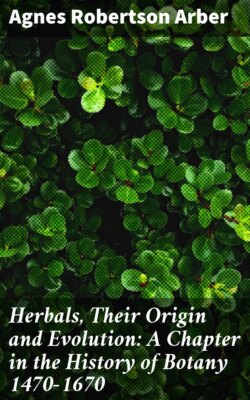Читать книгу Herbals, Their Origin and Evolution - Agnes Robertson Arber - Страница 9
На сайте Литреса книга снята с продажи.
1. The Encyclopædia of Bartholomæus Anglicus and ‘The Book of Nature.’
ОглавлениеTable of Contents
FTER the invention of printing, a very active period of book production followed, during which many works, which had previously passed a more or less lengthy existence in manuscript, were put into circulation in print, contemporaneously with books actually written at the time. The result is that a number of the “incunabula,” as printed books of the fifteenth century are technically called, are far more ancient, as regards the matter which they contain, than the date of their publication would seem to suggest.
This characteristic is illustrated in the Encyclopædia of Bartholomæus Anglicus, and in Konrad von Megenberg’s ‘Das půch der natur,’ which were perhaps the earliest printed books containing strictly botanical information. The former work, which was first printed about 1470, was compiled by a monk, sometimes called Bartholomew de Glanville, who flourished in the thirteenth century. The title by which it is generally known is ‘Liber de proprietatibus rerum.’ One of the sections of which it is composed is concerned with an account of a large number of trees and herbs, arranged in alphabetical order, and is chiefly occupied with their medicinal properties. It also includes some theoretical considerations about plants, on Aristotelian lines. An English translation, which was printed by Wynkyn de Worde before the end of the fifteenth century, is interesting as containing the very primitive botanical wood-cut reproduced in Text-fig. 19.
Plate III
Wood-cut of Plants [Konrad von Megenberg, Das půch der natur, 1475]. Reduced.
‘Das půch der natur’ is slightly later as regards the date of publication, having been printed by Hanns Bämler at Augsburg in 1475. It seems to have been very popular, for it passed through six or seven editions before the end of the fifteenth century. A very large number of manuscripts of ‘The Book of Nature’ exist, as many as eighteen being preserved in the Vienna Library and seventeen at Munich. The text is a compilation from old Latin writings, and is said to have been translated into German as early as 1349. The portion dealing with plants consists of an account of the virtues of eighty-nine herbs with their Latin and German names. The chief interest of the work, from our present point of view, lies in the fact that it contains the earliest known botanical wood engraving (Plate III). We shall return to this subject in Chapter VII.
